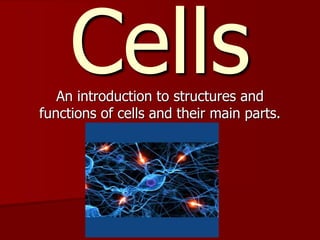Cell Parts & Organelles.ppt
- 1. An introduction to structures and functions of cells and their main parts. Cells
- 2. Cell Theory ŌĆó The Cell Theory states: ŌĆó All living organisms are composed of cells. They may be unicellular or multicellular. ŌĆó The cell is the basic unit of life. ŌĆó Cells arise from pre-existing cells.
- 3. Types of Cells ’ü« Identify: ŌĆō Bacterial cell ŌĆō Plant cell ŌĆō Animal cell
- 4. 1. Cell Wall ’ü« A) function: physical protection & structural support ’ü« B) Structure: wall surrounding cell ’é¦Has holes like windows in a wall ’ü« C) Macromol. = cellulose
- 5. A cell is found to have a nucleus and a cell wall. Which type of cell(s) can it not be. A. Plant B. Animal C. Bacteria
- 6. 2. Cell Membrane ’ü« A) function: controls what enters and leaves cell ’ü« B) Structure: flexible lining just inside cell wall ’ü« C) Macromol. ’ü« Phospholipids ’ü« Proteins
- 7. 3. Nucleus ’ü« A) Structure: ’ü« 1) Nuclear envelope = double layer of membrane around nucleus ’ü« 2) Nuclear pores = holes in envelope ’ü« 3) Chromosomes = DNA inside nucleus ’ü« 4) Nucleolus = area full of ribosome parts
- 8. ’ü« B) Function: Store DNA & direct cell ’ü« C) Macromol. ’ü« Phospholipids, proteins ’ü« Nucleic acids
- 9. 4.Cytoplasm ’ü« A) function: every thing that happenes between cell membrane and nucleus ’ü« B) Structure: ’ü« 1) all organelles between nucleus and cell membrane ’ü« 2) all fluid that fills cell = hyaloplasm ’ü« C) Macromol. : all
- 10. 5. Ribosome ’ü« A) function: make proteins ’ü« 1) Connect amino acids in correct order ’ü« 2) Follow directions from RNA ’ü« B) Structure: 2 subunits ’é¦ 1) Protien subunit ’é¦ 2) RNA subunit ’ü« C) Macromol. : protein & nucleic acid
- 11. 6 Mitochondrion ’ü« A- Function: Cellular Respiration ’ü« 1)Uses O2 to burn glucose & give cell energy ’ü« 2) O2 + glucose ’āĀ CO2 and energy ’ü« B- Structure ’ü« 1) Oval outer membrane ’ü« 2) Folded inner membrane ŌĆōFolds called cristae ’ü« C- Macromolecules: ’ü« Phospholipids, protein, nucleic acids
- 12. 7. Chloroplasts ’ü« A- Function: Photosynthesis ’ü« 1) Coverts solar Energy into chemical energy ’ü« 2) CO2 + H2O ’āĀ Glucose + O2 ’ü« B- Structure: ’ü« 1) Oval outer membrane ’ü« 2) Grana = stacks of thylakoid disks ’ü« C- Macromolecules: ’ü« Phospholipids, protein, nucleic acids
- 13. 8. Vacuole ’ü« A- Function: storage & support (plants) ’ü« B- Structure: membrane full of water and molecules or food ’ü« C- Macromolecules: ’ü« phospholipids, protiens
- 14. 9. Lysosome ’ü« A- Function: digest food/break down old organelles & macromolecules (hydrolysis) ’ü« B- Structure: membrane bubble full of enzymes ’ü« C- Macromolecules ’ü« phospholipids, proteins (enzymes)
- 17. 10. Golgi Body ’ü« A- Function: ’ü« 1) adds sugars & lipids to proteins ’ü« 2) makes complex carbohydrates ’ü« B- Structure: ’ü« 1) flat membrane pockets ’ü« 2) filled with enzymes ’ü« C- Macromolecules ’ü« phospholipids, proteins
- 18. 11. Rough Endoplasmic Reticulum ’ü« A- Function: Fold & transport proteins ’ü« B- Structure: ’ü« 1) Tunnels made of membrane ’ü« 2) lots of enzymes ’ü« 3) ribosomes ’ü« C- Macromol.: ’ü« phospholipids, proteins
- 19. 12. Smooth Endoplasmic Reticulum ’ü« A- Function: Transport molecules & Detox ’ü« B- Structure: Membrane tunnels full of enzymes ’ü« C- Macromol.: ’ü« phospholipids, proteins ’ü«
- 20. 13. Cytoskeleton ’ü« A- Function: ’ü« 1) internal support ’ü« 2) move organelles & vessicles ’ü« B- Structure: Framework of microtubules and motor proteins ’ü« C- Macromolecules ’ü« protein





















